Planning Advice Note 77: designing safer places
Planning Advice Note (PAN) 77 provides advice on how planning can help to create attractive well-managed environments which help to discourage antisocial and criminal behaviour.
This document is part of a collection
Creating Safer Places
The planning system alone cannot be responsible for tackling the social, economic and environmental problems which are usually evident in the areas most affected by crime. It does however, have a role to play in the design of safer places, either through small-scale improvements, such as the provision of appropriate landscaping, or through the master planning of a large-scale regeneration project.
The following section outlines general planning principles for consideration when creating safer places. They are grouped under the broad headings of context, identity and connection.
- Context
- Identity
- Connection
Context
Every new development must reflect a full understanding of the characteristics of the local area.
Location
- Local characteristics - Before planning a new development, developers, the local authority and other stakeholders must be aware of the crime characteristics of the local area and have a good understanding of the area's physical, social and economic circumstances. Discussions with the local authority and the police can help to identify these characteristics at an early stage in the process. Understanding problems in the locality should enable a better design solution.
- Orientation of buildings - Buildings should be orientated to overlook footpaths and public spaces. Careful consideration should be given to the position of doors and the location and height of windows.
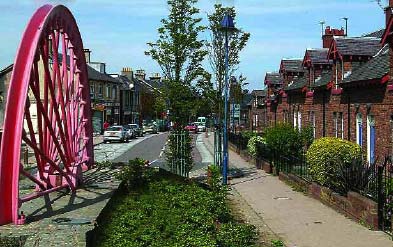
Newtongrange, Midlothian Use
- Encouraging mixed uses - Scottish Planning Policy ( SPP) 1 The Planning System promotes mixed use areas. An appropriate mix of uses can often encourage activity and movement at all times of day, thereby increasing natural surveillance and minimising the potential for crime.
- Compatibility - Local authorities should ensure that mixed uses are compatible with each other.
- Re-use of vacant and derelict sites - The re-use of vacant and derelict sites should be strongly encouraged. Bringing sites back into use can help to improve safety by creating a better quality environment. It may also enhance economic and employment opportunities.
Identity
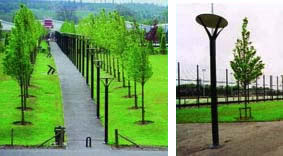
Lighting at Hamilton Palace, South Lanarkshire Creating identity and a sense of place can help to provide a feeling of safety and security.
Landscape
- Boundary treatments - Appropriate boundary treatment can help to increase the feeling of community ownership and responsibility. Walls, fences, hedges and changes in levels or materials can all help to define public, private and semi-private spaces. Care should be taken to ensure that the boundary treatment is appropriate for its location and is well maintained. Boundary treatments should be functional without compromising the aesthetics of the surrounding area or other safety principles, such as natural surveillance.
- Lighting - There is a general acceptance that high quality external lighting can help to reduce the incidence of crime. It can add vitality to an area, enhancing its attractiveness and sense of place and the reassurance it offers can also reduce the feeling of vulnerability. Effective lighting also increases potential offenders' feeling of exposure and improves the chances of identification and detection.
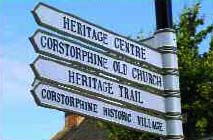
Signage, EdinburghIt is important to ensure that lighting does not dazzle or create pockets of darkness.
When considering the most appropriate type of lighting, the following issues should be taken into account: location, siting, relationship and distribution of other lighting, aesthetic design, intensity, timing (taking into account seasonal differences), resistance to vandalism, and the cost, frequency and ease of maintenance.
- Signage - Clear and uncluttered signage, particularly for pedestrians, can help to direct people to the most appropriate route, thereby creating a feeling of confidence and security.
-
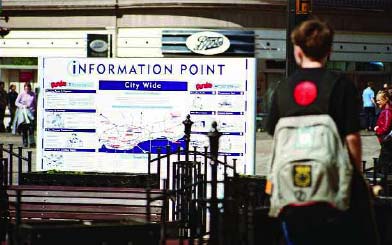
City Centre, Dundee Play - Careful thought is required in the provision of children's play facilities. Purpose designed play areas for younger children should be small-scale and sited close to dwellings with maximum opportunity for surveillance. To prevent damage, facilities and fittings should be robust, suitable for their intended use and securely fixed.
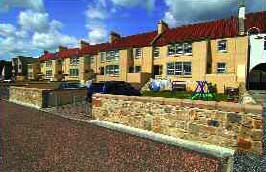
West Wemyss, Fife 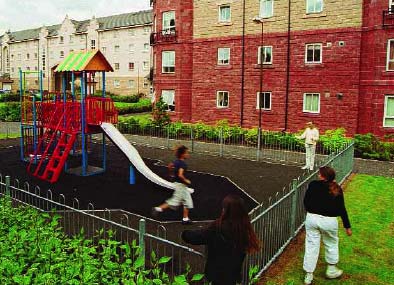
McDonald Road, Edinburgh Play provision for older youths should not be made immediately adjacent to housing but facilities such as kick-about pitches should still have a high level of natural surveillance not only from a child safety point of view but also to deter antisocial behaviour.
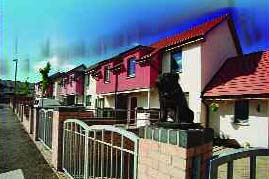
Craigmillar, Edinburgh Security Measures
- Shutters - Security shutters illustrate the tension that can exist between effective crime prevention and the need to maintain or improve the environmental quality of an area. The creation of a fortress like atmosphere by the use of shutters can be self defeating because an area can be given a hostile and confrontational appearance, particularly as shutters are vulnerable to graffiti. This can discourage the public from using the area and the benefits of natural surveillance are lost. Where the need for the provision of shutters is identified, an appropriate balance between security and environmental quality should be sought.
-
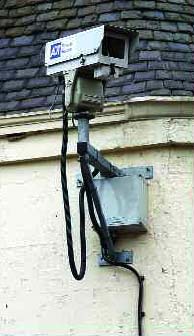
Closed circuit television camera Closed Circuit Television ( CCTV) - Natural surveillance is a key component in creating safer places and a variety of measures to maximise natural surveillance have been outlined elsewhere in this PAN. Where the risk of crime is high, natural surveillance may need to be complemented by a more formal surveillance mechanism, the most common of which is CCTV. CCTV schemes are now a common feature in many streetscapes and play a vital role in the surveillance and monitoring of our public spaces, helping to provide a greater sense of community safety and security.
The siting and design of CCTV cameras should be carefully considered to ensure their presence is known, without being over dominant in the street scene.
CCTV is most effective when implemented as part of a wider package of security measures, including complimentary lighting, adequate natural surveillance and appropriate formal monitoring. Scottish Police Forces have CCTV officers who can provide further advice.
Connection
Direct, well connected routes can maximise opportunities for natural surveillance and visibility, thereby helping to create a safe environment.
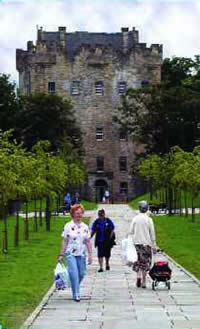
Alloa Tower Layout
- Natural surveillance - When considering the layout of any new development, one of the most important issues to consider is creating the opportunity for natural surveillance. Buildings, spaces and pedestrian routes should be located to maximise natural observation from pedestrians and passing motorists. Active frontages should be encouraged wherever possible i.e. doors leading onto the street and windows overlooking all public areas.
Movement
- Safety and speed - Slowing traffic down can contribute to a safe and attractive environment. Speed reducing measures should be incorporated into the design of any new development, rather than the reactive provision of traffic calming measures such as road humps and chicanes. PAN 76 New Residential Streets provides further guidance on speed reduction measures in residential areas.
- Pedestrians - Pedestrian routes should have an open aspect, be well lit and give a good level of surveillance. The pedestrian should be able to view the full length of the path on entry rather than negotiate blind corners or recesses. Landscaping adjacent to footpaths must be at a low level and well maintained.
Pedestrianisation can often help to create a safe environment in town centres and other busy areas. However, at non-peak times, particularly at night, the exclusion of cars can sometimes lead to a more threatening environment. Mixed use developments, particularly the provision of residential accommodation above commercial premises, can help to provide natural surveillance to pedestrianised streets.
- Parking - Cars parked in car parks which are remote, unsupervised and out of sight are at considerable risk to theft or damage. All vehicle parking should be subject to good natural surveillance and the use of appropriate lighting should be carefully considered.
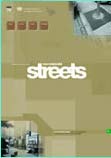 The Safer Parking Scheme is a UK initiative of the Association of Chief Police Officers ( ACPO) aimed at reducing crime and the fear of crime in parking facilities. It is part of the 'Secured by Design' Initiative and is supported by the Home Office and Scottish Executive. ParkMark TM is the new accreditation mark which is used to promote the scheme to the general public. It symbolises that a parking facility has also been independently vetted by the police and provides for an environment where users can be confident that the safety of themselves and their property is taken seriously by the car park operators. Further information about the initiative, along with the core principles can be found at: www.britishparking.co.uk
The Safer Parking Scheme is a UK initiative of the Association of Chief Police Officers ( ACPO) aimed at reducing crime and the fear of crime in parking facilities. It is part of the 'Secured by Design' Initiative and is supported by the Home Office and Scottish Executive. ParkMark TM is the new accreditation mark which is used to promote the scheme to the general public. It symbolises that a parking facility has also been independently vetted by the police and provides for an environment where users can be confident that the safety of themselves and their property is taken seriously by the car park operators. Further information about the initiative, along with the core principles can be found at: www.britishparking.co.uk
In urban areas, underground parking can often offer an appropriate parking solution that effectively uses valuable land and may provide a more aesthetically pleasing design solution. However, underground car parks have extremely limited natural surveillance and should therefore be designed with adequate access control measures and formal surveillance mechanisms.
All parking within residential areas should benefit from good levels of natural surveillance. If there is a requirement for parking within the curtilage of the dwelling, the vehicle should be visible without dominating the front of the dwelling.
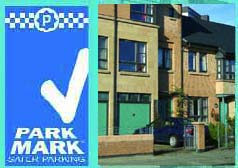 Gorbals, Glasgow |
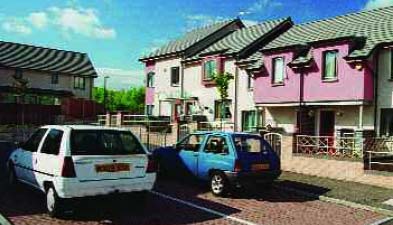 Craigmillar, Edinburgh |
Contact
There is a problem
Thanks for your feedback